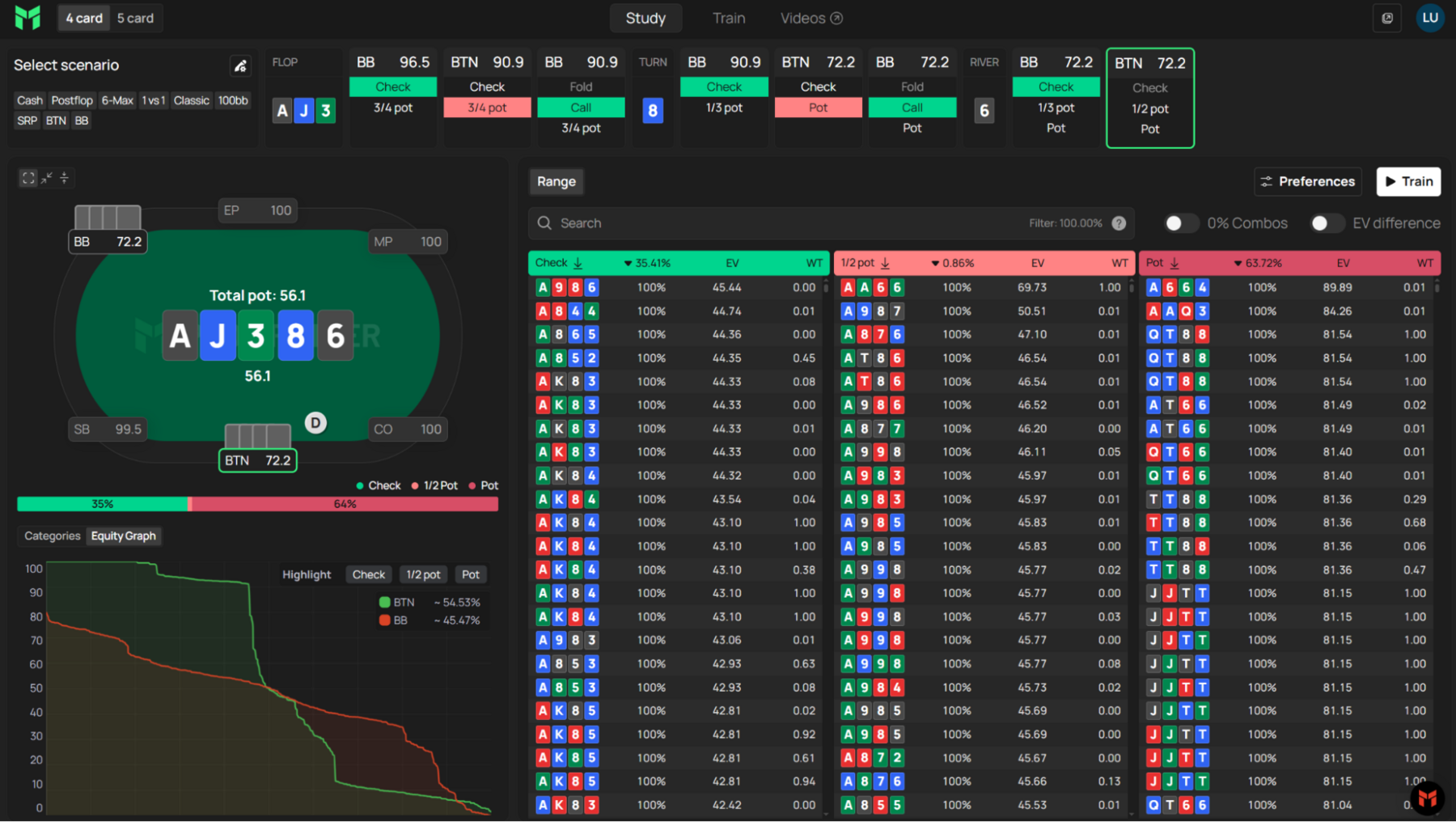
If your winrate is leaking from the big blind in Pot Limit Omaha, you’re not alone. It’s one of the highest-frequency spots in PLO cash games, and it’s where even solid players torch stacks by being too sticky vs c-bets or blasting the wrong check-raises. In his latest PLO Mastermind stream, Fernando “JNandez” Habegger fires up the PLO Trainer and speed-drills exactly this node—single-raised pots, BB vs IP, out of position—laying out practical rules you can apply in your next session. As a an obsessive node-picker myself, I love when JNandez cuts through the noise and shows the actual thresholds and side-card effects that move EV.
Below I’ll give you the quick hits, the full “playbook,” and a short guide to using PLO Trainer (inside PLO Mastermind) to lock the skills.
Watch the video here
6 rapid-fire takeaways from the stream (save these)
- Check-fold baseline matters. Around half-pot c-bets, your defense target is anchored by MDF; in BB OOP you’ll often land near ~45–50% defend, with raises counting “more” than calls. Train the split (fold/call/raise), not just “defend or not.”
- Don’t auto-blast “protection.” “Betting to protect” is often just lighting equity on fire. If your hand hates getting check-raised, it probably wasn’t a bet. (Think “preserve outs” and future playability instead.)
- Top set ≠ middle set. JNandez shows top set as a high-frequency check-raise; middle set sometimes needs backup (wrap/BDFD) or more calls. That “backup density” is the difference between stack-in and just realize.
- Leading (donk) has a job. Low, symmetric boards (and deeper stacks) are prime for small donks that create turn polarity OOP; you’re not “random donking,” you’re shaping ranges to win the turn.
- Equity realization beats raw equity. Calling with disconnected one-pair trash from BB because you “have 33%” is a losing habit; connection + suit density drives realization OOP.
- Study like a grinder, not a highlight reel. Fast-timed drills (5–10s decisions) in PLO Trainer build the pattern memory you need under pressure. Consistency > vibes. Also: bring presence to the table; calm, focused reps translate best.

The Big Blind Postflop Playbook (BB vs IP, SRP)
Flop — default map
- Check-fold the true air. If your hand neither meets MDF via call nor holds the blockers/backup to raise profitably, muck it and print future EV. MDF is a compass, not a commandment.
- Check-call the smooth stuff. One-pair + BDFD/GS; nut gutters with BDFD; hands that improve well and don’t hate turn barrels. Equity realization first, always.
- Check-raise ~10% (as a base). Go hard with top set, and pick middle set only when you have wrap/BDFD scaffolding. Mix in blocker-driven raises (e.g., top-pair + BDFD that pressure overpairs and non-nut BDFDs).
- Lead (donk) selectively, especially deeper. Small leads on low, symmetric textures build turn polarity.
About the PLO Trainer (inside PLO Mastermind)

What it is: A structured drilling tool for Pot Limit Omaha (4-card and 5 Card PLO) built by Fernando Habegger and the PLO Mastermind team. You choose the node (e.g., SRP BB vs BTN, Flop/Turn/River), set a time bank, and hammer reps while tracking EV diffs, frequencies, and filters (sets, BDFD, wraps, etc.). (Small-stakes players: solvers/drills are absolutely useful when applied to population tendencies.)
Latest PLO Trainer Updates:
Why this matters for your PLO Cash Game Strategy
The big blind is your volume node. Tighter folds vs bad-EV calls, disciplined check-raises, high-EV donks on the right textures, and cleaner river plans tighten your redline and stop the bleed. This is the kind of routine, unsexy edge that drives winrate—whether you’re grinding 4-card or 5 Card PLO. When you train this spot in PLO Trainer, you’ll feel the decisions compress into easy patterns: defend targets, raise classes, and turn heuristics you can trust. That’s the whole PLO Cash Game Strategy game.
Small reminder from Fernando Habegger’s long-standing approach: build a baseline (GTO-informed), then exploit the pool deviations—most pools still over-c-bet IP and overfold vs flop raises at small/mid stakes. Structure your ranges accordingly.
And don’t ignore the human side: presence + calm focus make study stick and keep you from “heat-blasting” nodes in real time. Short pre-session breathwork or simple awareness loops help you execute the plan you drilled.
Conclusion
JNandez did what he does best: turned a messy, high-frequency spot into a handful of reliable rules. Use the video to see the exact combos; use PLO Trainer to wire the patterns. If you’re serious about PLO Cash Game Strategy, this is bread-and-butter work, and PLO Mastermind is the cleanest path I’ve seen to doing it right.
Key Takeaways
- BB OOP vs SRP is a drillable node—set defend targets and split fold/call/raise correctly.
- Prioritize equity realization; stop calling disconnected one-pair junk OOP.
- Top set: raise a lot; middle set: need wraps/BDFDs or call more.
- Small donks on the right boards (deeper stacks) are a weapon, not a leak.
- Kill the “protection bet” reflex; preserve outs and avoid being blown off equity.
- Drill daily inside PLO Mastermind’s PLO Trainer; weave in 5 Card PLO modules as you scale.
As a PLO enthusiast with nearly 12 years of experience, I’m passionate about breaking down the complexities of Pot Limit Omaha, helping you sharpen your strategy and grow your bankroll – no matter your current level. I also share exclusive bonus and rakeback deals, along with discounts on poker courses and tools, so you can get an extra edge. When I’m not writing, you’ll usually find me online, playing PLO cash games and turbo MTTs.

